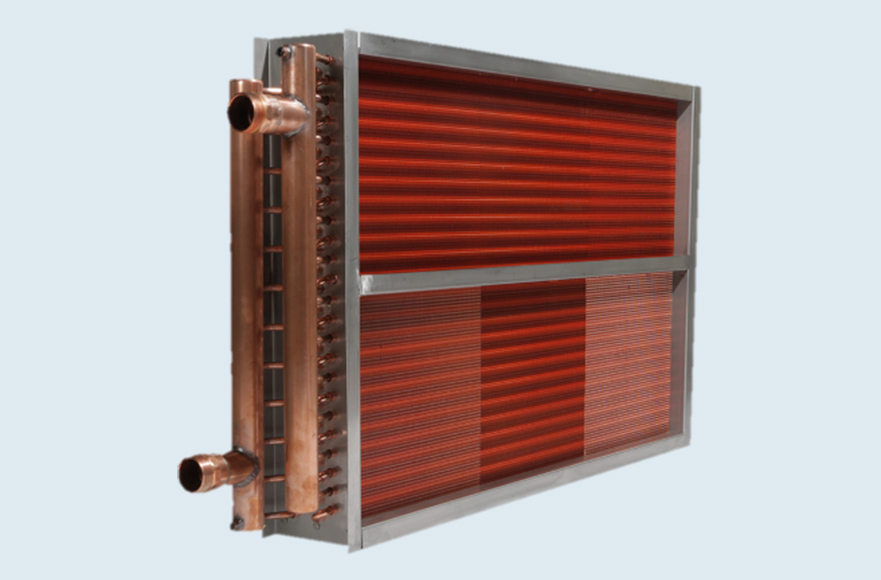The Ins and Outs of Specifying Coil Construction

There are many alternatives available in the specifying of coils and their construction, and it’s based on the specific requirements of each project. What might work on one project may not be applicable for another. When you consider projects with adverse temperature, pressures, and corrosive agents into the mix, the discussion needs to include what construction will yield the highest longevity at a reasonable cost.
Tube Diameter
There are 3 major tube diameters in the HVAC industry. They are 3/8”, ½” and 5/8” outside diameter (OD) tubes. The selection of tube diameter is almost always based on liquid velocity in the tubes.
Tube Wall Thickness
A standard wall thickness comes with these 3 tube diameters. Currently, 3/8” OD tubes have .014 tube wall thickness, ½” OD tubes have .017 tube wall thickness, and 5/8” OD have .020” tube wall thickness. Tube wall thickness deals directly with pressure and better brazed joints.
Normal HVAC pressures for both refrigerant and water coil applications can use standard wall thickness. When pressures get beyond normal, it’s a good idea to ask the manufacturer for a heavier wall thickness.
As mentioned, tube wall thickness has a lot to do with brazed joints in coils. The heavier the tube wall thickness, the more material there is to braze the tube to a return bend of header. Any braze expert will tell you a heavier wall will always provide a stronger joint, as more braze material and heat can be applied at this point.
Fin Material
There are two construction alternatives in HVAC coils – 1) aluminum or 2) copper fin material. There must be a unique reason to specify copper, as the current price of copper adds more than double to the overall price of a coil. Aluminum should be the choice. There is only about an added 2 % difference in heat transfer between copper and aluminum. That should never be the reason why you would specify copper with its huge price tag.
There are many different fin patterns that create more heat transfer but also more resistance. You can’t have one without the other. If air has increased contact with the finned surface, a positive and negative aspect occurs. There’s more heat transfer but far more resistance. A coil selection specialist can assist you with selecting a balance between good efficiency and lower air resistance.
Remember:
1) Fin “patterns” deal with cleanability. If you want to clean a coil due to problems with coil surfaces over time, you must let the coil specialist know this before selecting the finned surface for you.
2) Fin “thickness” also deals with cleanability issues. The thicker the fin, the use of higher pressure water or solvents can be applied without matting of the surface. By the way, the thicker the fin, the more heat transfer but also more resistance.
Casing
Casing includes the tube sheets, metal flanges, and intermediate casing and tube supports. There are essentially 3 options. The 1st is standard galvanized steel. The other alternatives are aluminum or 304 stainless steel. Most times, dry coils do not need an alternative material, but water or DX cooling coils that have airside moisture will often have a much longer life with aluminum or stainless steel.
Remember:
Galvanized is a zinc coating on steel. If water continues to run across galvanized steel, the galvanizing will be compromised and create rust or corrosion.
Coatings
For years dipped and baked coatings have become an integral part of the coil selection landscape. They are almost always used for corrosion protection, and none of them reduce heat transfer by more than 1-1/2%. The words “dipped and baked” have become an important part of a specifier’s vocabulary.
There are “spray coatings” that have been used in our industry that do not meet the requirements of a quality coating. Most times, these spray coatings do not have the ability to get into the entire area of a coil – especially where the tube and fin meet. Without complete coverage a coil can fail in these areas.
Steam Heating Coils
These coils are in their own category, because they both experience pressure related problems and condensate corrosion as well. It’s important to remember that tube wall thickness has little to do with the limiting of corrosion. Either a material is corrosion resistant, or it isn’t. Fabricating a coil with heavier tube walls because you have failures probably won’t help with longevity.
Many steam coils are operating at pressures well above normal. If you operate a steam heating coil at higher pressure, it may be logical to increase the tube wall thickness. Steam coils experience different pressure problems than other HVAC coils, because they often have steam colliding with condensate inside the coil. Have your coil specialist define the problem and specify a coil that will last longer in your system.
Thought for the day!
A married man should forget his mistakes. There’s no point in two people remembering the same thing!


